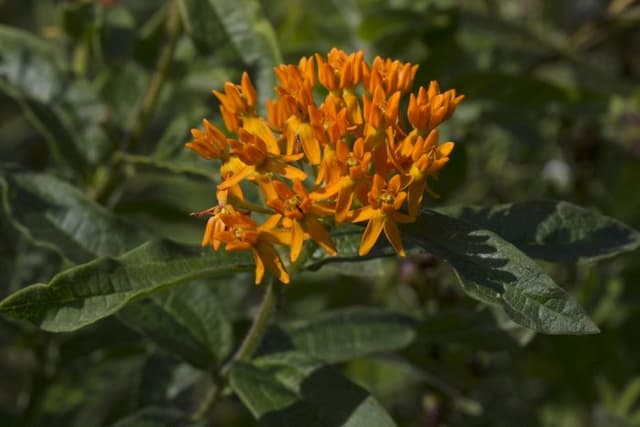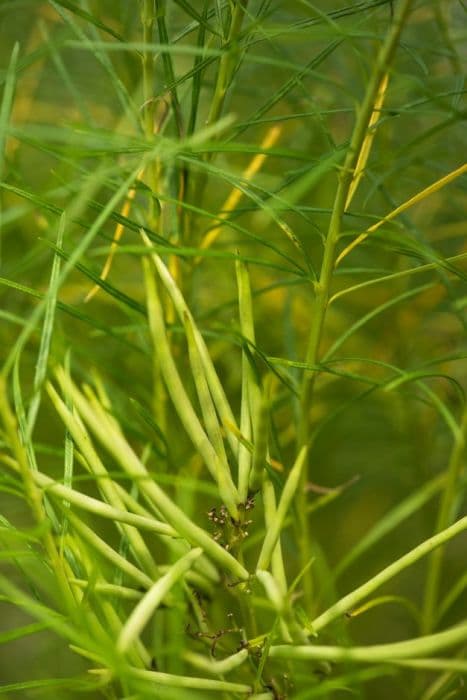Madagascar Periwinkle Catharanthus roseus (Albus Group) 'Albus'

ABOUT
The 'Albus' variety of the Madagascar periwinkle plant is adorned with striking, pure white flowers. Each blossom typically showcases five petal-like lobes that radiate from the center, creating a pinwheel-like effect. The petals are waxy and smooth, often with a delicate, velvety texture which gives them a lustrous appearance. In the center of the flowers, a contrasting small eye of yellowish or greenish hues can be seen, which adds a charming visual interest. The foliage of the Madagascar periwinkle 'Albus' is glossy and vibrant green. The leaves are oval to oblong-shaped with a smooth margin, and they grow opposite to each other on the stems, creating a full and lush appearance. The stems themselves are slender and can range in color from green to a reddish hue, depending on environmental conditions. The overall aspect of the plant is neat and bushy, presenting a well-balanced and rounded form. This ornamental plant is not only appreciated for its lovely flowers but also for its attractive, evergreen foliage which provides interest even when the plant is not in bloom. Madagascar periwinkle 'Albus' is a popular choice for gardens due to its ability to add a continuous splash of white to landscapes, and it is also used for creating borders or as a ground cover in suitable climates.
About this plant
 Names
NamesFamily
Apocynaceae.
Synonyms
Madagascar Periwinkle, Vinca, Rosy Periwinkle, Cape Periwinkle, Old Maid.
Common names
Vinca rosea, Lochnera rosea, Ammocallis rosea, Catharanthus roseus.
 Toxicity
ToxicityTo humans
Madagascar periwinkle is considered toxic if ingested by humans. The whole plant contains alkaloids, such as vincristine and vinblastine, which can cause potentially severe symptoms when ingested. Symptoms of poisoning can include vomiting, diarrhea, low blood pressure, depression of the central nervous system, and in extreme cases, seizures, coma, and death. Due to these toxic effects, consumption of any part of the Madagascar periwinkle should be avoided.
To pets
Madagascar periwinkle is also toxic to pets if ingested. The presence of alkaloids, such as vincristine and vinblastine, can cause a range of symptoms in animals. These may include vomiting, diarrhea, drops in blood pressure, depression, incoordination, and seizures. In severe cases, it can lead to potentially fatal outcomes. Pet owners should ensure that their animals do not consume any part of the Madagascar periwinkle plant.
 Characteristics
CharacteristicsLife cycle
Perennials
Foliage type
Evergreen
Color of leaves
Green
Flower color
White
Height
1-2 feet (30-60 cm)
Spread
1-2 feet (30-60 cm)
Plant type
Herb
Hardiness zones
10
Native area
Madagascar
Benefits
 General Benefits
General Benefits- Ornamental Appeal: Catharanthus roseus 'Albus', commonly known as White Periwinkle, features attractive glossy green foliage and pure white flowers that provide visual interest to gardens and landscapes.
- Drought Tolerance: Once established, White Periwinkle is known for its ability to endure periods of dryness, making it suitable for xeriscaping and drought-prone regions.
- Low Maintenance: This plant is relatively easy to care for, requiring minimal upkeep beyond basic watering and occasional pruning to keep it looking tidy.
- Pest Resistance: White Periwinkle is resistant to many pests, reducing the need for chemical treatments and making it a safer choice for gardens frequented by pets and children.
- Heat Tolerance: It thrives in hot climates, making it a good choice for gardens in warmer regions where other plants might struggle.
- Ground Cover: When planted in groups, Catharanthus roseus 'Albus' serves as an effective ground cover, suppressing weeds and reducing soil erosion with its dense foliage.
 Medical Properties
Medical Properties- Antineoplastic agent: Contains alkaloids such as vincristine and vinblastine, used to treat various cancers.
- Antidiabetic potential: Alkaloids and other compounds may have potential in managing diabetes.
- Hypotensive activity: Can lower blood pressure due to alkaloid content, particularly ajmalicine.
- Antimicrobial properties: Exhibits antibacterial and antifungal properties.
- Sedative effect: Ajmalicine may act as a sedative.
- Cytotoxic effects: Various alkaloids exhibit cytotoxicity towards cancer cells.
 Air-purifying Qualities
Air-purifying QualitiesThis plant is not specifically known for air purifying qualities.
 Other Uses
Other Uses- Madagascar periwinkle is often used in traditional garlands and religious ceremonies. The flowers are strung together and used in offerings or decorations.
- In some cultures, this plant's sap is used as a traditional dye for fabrics, lending a pinkish hue to the clothes.
- The durability and vibrant color of the flowers make them an attractive option for natural confetti at weddings or celebrations.
- Dried Madagascar periwinkle is sometimes incorporated into potpourri mixes, contributing to the visual appeal and overall fragrance of the blend.
- The plant's aesthetic appeal makes it useful as a natural ornamental element in crafting, such as in scrapbooking or card making.
- In regions where it grows abundantly, the Madagascar periwinkle is used to create living fences or boundaries due to its dense growing habit.
- As a model organism in science education, students can study plant biology and the effects of environmental changes on its growth.
- Its resilient nature makes the Madagascar periwinkle suitable for rehabilitation projects in degraded lands or for erosion control.
- Used in landscaping, the Madagascar periwinkle is handy for creating colorful ground cover that requires relatively low maintenance.
- In floristry, fresh or dried Madagascar periwinkle is used in floral arrangements to give them a splash of color and long-lasting decor.
Interesting Facts
 Feng Shui
Feng ShuiThe Vinca is not used in Feng Shui practice.
 Zodiac Sign Compitability
Zodiac Sign CompitabilityThe Vinca is not used in astrology practice.
 Plant Symbolism
Plant Symbolism- Purity: The white color of 'Albus' symbolizes purity and innocence, often connected to new beginnings and clean slates.
- Hope: Catharanthus roseus, commonly known as Vinca or Madagascar Periwinkle, is often seen as a symbol of hope due to its ability to thrive in adverse conditions.
- Endurance: As a plant that can withstand full sun and drought, Vinca represents endurance and the ability to persist through challenges.
- Healing: This species is known for its medicinal properties, especially in traditional medicine, which makes it symbolize healing and restoration.
 Water
WaterMadagascar periwinkle, commonly known as Vinca, should be watered regularly but sparingly, allowing the soil to dry out between waterings to prevent root rot. This plant is drought-tolerant once established, so it's essential not to overwater it. In general, watering once a week with one to two gallons of water is sufficient, depending on the weather and soil conditions. During hot, dry periods, more frequent watering may be necessary. Always check the top inch of soil for dryness before watering.
 Light
LightFor Vinca, bright, indirect light is ideal. A spot that receives morning sunlight with shade in the afternoon is perfect. Avoid placing the plant in full, harsh sunlight as this can lead to scorching of the leaves. It'll thrive in light conditions that mimic those of its native habitat, which include partially shaded areas.
 Temperature
TemperatureVinca prefers warm temperatures and does not tolerate frost. The plant can survive minimum temperatures of around 60 degrees Fahrenheit but thrives in a range of 70 to 85 degrees Fahrenheit. It's a tropical plant, so sustained temperatures below 60 degrees Fahrenheit can damage or kill it. Be sure to protect the plant from cold drafts and frost exposure.
 Pruning
PruningVinca benefits from regular pruning to encourage bushy growth and more abundant flowering. It should be pruned in early spring before new growth begins. Deadheading spent flowers throughout the growing season will also promote further blooming. Pruning can be done every few weeks during the active growing season to maintain shape and health.
 Cleaning
CleaningAs needed
 Soil
SoilMadagascar periwinkle thrives in well-draining soil with a mix of two parts peat, one part perlite, and one part compost. Aim for a soil pH between 6.0 to 7.5 for optimal growth.
 Repotting
RepottingMadagascar periwinkle should be repotted every 2-3 years, or when it becomes root-bound and the growth starts to slow down.
 Humidity & Misting
Humidity & MistingMadagascar periwinkle prefers moderate to high humidity levels but is quite adaptable and can tolerate lower humidity if necessary.
 Suitable locations
Suitable locationsIndoor
Place in bright, indirect light and water when top soil feels dry.
Outdoor
Plant in full sun to part shade and water regularly.
Hardiness zone
10-11 USDA
 Life cycle
Life cycleMadagascan periwinkle 'Albus' begins its life cycle as a seed, which germinates in warm, moist soil conditions to produce a small seedling. The seedling soon develops true leaves and, as it matures into a young plant, it starts to form a bushy habit with glossy green foliage and stems. The plant then enters a vegetative growth phase where it continues to increase in size and may require pinching to promote bushier growth. Following the vegetative stage, the Madagascan periwinkle 'Albus' reaches maturity and begins its flowering phase, producing distinctive white, funnel-shaped flowers that attract pollinators. After pollination, the flowers give way to small fruit pods containing seeds, which can be dispersed by wind or water, or collected for propagation. The plant may go into a period of dormancy in cooler temperatures and can be perennial in warmer climates, where it will continue its cycle the following season.
 Propogation
PropogationPropogation time
Spring-Summer
The most popular method of propagating Catharanthus roseus 'Albus', commonly known as white Vinca or Madagascar periwinkle, is through seed. Sow Vinca seeds indoors 10 to 12 weeks before the last frost date for your area. Use a well-draining seed starting mix and lightly cover the seeds as they require darkness for optimal germination. Keep the soil temperature around 75 to 80 degrees Fahrenheit (24 to 27 degrees Celsius), and maintain consistent moisture without allowing the medium to become waterlogged. Seedlings usually emerge in 10 to 21 days and should be grown on in bright, indirect light until all risk of frost has passed and they are large enough to be transplanted outdoors.









